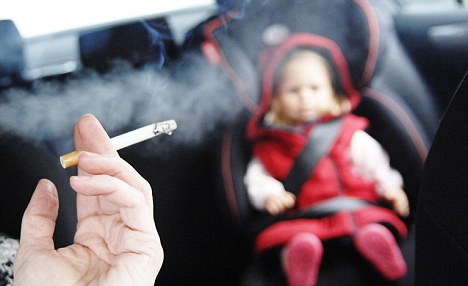
As per Global Youth Tobacco Survey, a school-based survey of students in grades 8, 9, and 10 conducted in 2009, one in five students live in homes where others smoke, and more than one-third of the students are exposed to smoke around others outside of the home; one-quarter of the students have at least one parent who smokes.
Exposure to second hand smoke results in lung cancer and heart diseases among adults, and SIDS (Sudden Infant Death Syndrome), chronic respiratory infections, exacerbation/worsening of asthma, reduced lung function growth, middle ear diseases, and acute respiratory illnesses among children. Smoking in the home affects babies and young children as well as the elderly and other adults, especially women.
The Government has taken measures including, inter alia, the following to curb smoking: (i) Enactment of the �Cigarettes and other Tobacco Products (Prohibition of Advertisement and Regulation of Trade and Commerce, Production, Supply and Distribution) Act, (COTPA) 2003�.
(ii) Ratification of WHO Framework Convention on Tobacco Control.
(iii) Launch of the National Tobacco Control Programme (NTCP) in the year 2007-08, with the objectives to (a) create awareness about the harmful effects of tobacco consumption, (b) reduce the production and supply of tobacco products, (c) ensure effective implementation of the anti-tobacco laws and (d) help the people quit tobacco use through Tobacco Cessation Centres.
(iv) Notification of rules to ban smoking in public places.
(v) Notification of rules to regulate depiction of tobacco products or their use in films and TV programmes.
(vi) Notification of rules on new pictorial health warnings on tobacco product packages.
(vii) Launch of public awareness campaigns through a variety of media. v Government of India has banned certain kinds of smokeless tobacco products like gutkha and chewing tobacco through the notification issued under the Food Safety and Standards Act, 2006. Other tobacco products are regulated by the Cigarettes and other Tobacco Products (Prohibition of Advertisement and Regulation of Trade and Commerce, Production, Supply and Distribution) Act, 2003 (COTPA 2003), which contain provisions, inter alia, relating to ban on sale of tobacco products by/to minors, ban on sale of tobacco products within 100 yards of educational institutions, ban on promotions/advertisements of tobacco products, etc.
The State Governments/UTs of Uttarakhand, Punjab, Rajasthan, Haryana, Mizoram, Chandigarh, Uttar Pradesh, and Jharkhand have issued orders/notifications banning the sale of loose cigarettes.






